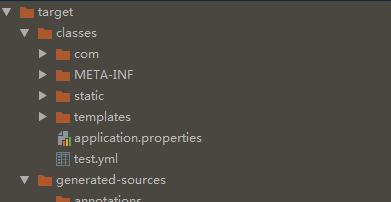Spring Boot 配置文件
主要说下 properties & yml
下面来看下
application.properties的文件格式
Spring.datasource.url=jdbc:mysql://192.168.0.233:3306/test1?useSSL=false
Spring.datasource.username=uoso
Spring.datasource.password=uosotech_123
Spring.datasource.driver-class-name=com.mysql.jdbc.Driver
yml配置格式
spring1:
url1: dbc:mysql://192.168.0.102:3306/test1?useSSL=false
那么在代码中我们怎么来使用这些配置文件呢?
这里要介绍的就是注解 @Component 、 @Value 的使用了
默认只要编写名称为application.*.yml 都是能够被直接使用的,只需要把 配置文件映射到类的属性里面,代码如下
@Componentpublic classPropertiesConfig {
@Value("${Spring.datasource.url}")privateString database;publicString getDatabase() {returndatabase;
}public voidsetDatabase(String database) {this.database =database;
}
}
如果世界使用的application.yml 能够自动被填充的配置资源里面,写法给上面样就能拿到配置
我这里自定义一个yml 如:test.yml
这里需要添加依赖
org.springframework.boot
spring-boot-configuration-processor
true
重新构建后,我新建一个class ,这里需要说明的就是 @ProtertySource 指定yml的路径 需要注意是的 classpath 这个指向的地址,是打包后的目录,调试的时候肯定找不到对应路径目录的文件需要自己配置下,否则就放在下图的目录结构

@Component
@PropertySource(value= "classpath:/test.yml")
@ConfigurationProperties(prefix= "spring1")public classYMLConfig {publicString getUrl1() {returnurl1;
}public voidsetUrl1(String url1) {this.url1 =url1;
}
@Value("${url1}")private String url1;
使用通过注解 @Autowired \ @Resource 都可以
//测试yml配置
@AutowiredprivateYMLConfig ymlConfig;
@Testpublic voidtestYmlConfig()
{
System.out.print(ymlConfig.getUrl1());
}


得到了我们想要的结果,下面在来说下.NetCore中的配置使用情况
.NetCore 配置文件
.NetCore提供了json 、xml 的方式来实现配置,这里我以json 来举个例子看下使用方式
默认也有一个appsettings.json 的文件,在不使用自定义配置的情况下,系统会加载这个配置文件 ,那么如果要把配置文件映射到class里面需要怎么处理呢?
下来创建一个配置类
public classAuthorityConfig
{public string Authority { get; set; }public bool RequireHttpsMetadata { get; set; }
}
在appsetting里面我们根据目录结构添加即可
"AuthorityConfig": {"Authority": "http://localhost:20001","RequireHttpsMetadata": false}
那么怎么把这两个Bind起来呢? 前面可以看到Java是通过@Value注解
.NetCore则是通过 在Startup 启动类中添加服务 里面有 IConfiguration 接口,根据这个接口来操作即可
services.AddOptions();
services.Configure(Configuration.GetSection("AuthorityConfig"));
根据节点位置配置关联的类,需要使用的时候通过构造函数注入即可
如果需要添加自定义的配置,我们使用启动类的构建来创建相关路径下的相关文件绑定到配置中Configuration 最后通过 Configuration 来绑定 Class之间的关系
publicStartup(IConfiguration configuration, IHostingEnvironment env)
{var configurationbuilder = newConfigurationBuilder()
.SetBasePath(env.ContentRootPath)
.AddJsonFile($"appsettings.json", optional: true, reloadOnChange: true)
.AddXmlFile($"appsettings.xml", optional: true, reloadOnChange: true)
.AddEnvironmentVariables();
Configuration=configurationbuilder.Build();//Configuration = configuration;
}
总结
其实 Spring Boot中也有其他的方式加载自定义的文件 ,这里的 ConfugurationBuilder 跟 Spring Boot中的 PropertySourcesPlaceholderConfigurer 类似,Java还提供了2中创建方式
1、YamlPropertiesFactoryBean yaml = new YamlPropertiesFactoryBean();
2、YamlPropertySourceLoader loader = new YamlPropertySourceLoader();
MutablePropertySources sources = new MutablePropertySources();
可以看到第二种里面多了MutablePropertySources,英文上就是加载多个资源文件的,事实就是这个意思,加载多个资源文件,而第一种没抛出异常
下面来解析下第一种:看源码
public class YamlPropertiesFactoryBean extends YamlProcessor implements FactoryBean, InitializingBean {private boolean singleton = true;
@NullableprivateProperties properties;publicYamlPropertiesFactoryBean() {
}public void setSingleton(booleansingleton) {this.singleton =singleton;
}public booleanisSingleton() {return this.singleton;
}public voidafterPropertiesSet() {if (this.isSingleton()) {this.properties = this.createProperties();
}
}
没有异常,而且是单例
看下第二种的源码,抛出了IO异常,在找不到文件目录文件的情况下会抛出异常
public class YamlPropertySourceLoader implementsPropertySourceLoader {publicYamlPropertySourceLoader() {
}publicString[] getFileExtensions() {return new String[]{"yml", "yaml"};
}public List> load(String name, Resource resource) throwsIOException {if (!ClassUtils.isPresent("org.yaml.snakeyaml.Yaml", (ClassLoader)null)) {throw new IllegalStateException("Attempted to load " + name + " but snakeyaml was not found on the classpath");
}else{
List> loaded = (newOriginTrackedYamlLoader(resource)).load();if(loaded.isEmpty()) {returnCollections.emptyList();
}else{
List> propertySources = newArrayList(loaded.size());for(int i = 0; i < loaded.size(); ++i) {
String documentNumber= loaded.size() != 1 ? " (document #" + i + ")" : "";
propertySources.add(new OriginTrackedMapPropertySource(name +documentNumber, (Map)loaded.get(i)));
}returnpropertySources;
}
}
}
}
配置这一块就说道这里~~~
下一章来介绍下自定的注解,同时也会结合.NetCore自定义属性标签来比较来时比较说明。





















 1406
1406











 被折叠的 条评论
为什么被折叠?
被折叠的 条评论
为什么被折叠?








